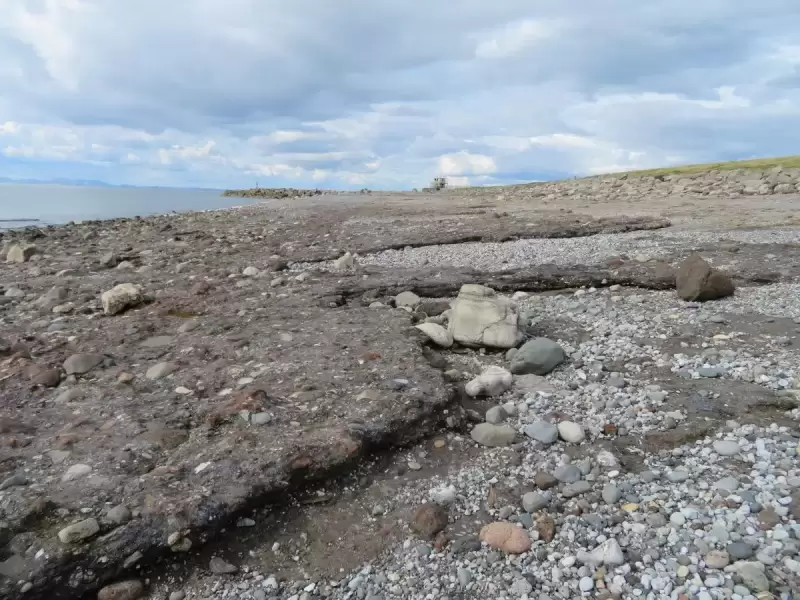 |
|
 |
|
 |
|
 |
|
 |
|
 |
|
 |
|
 |
|
 |
|
 |
|
 |
|
 |
|
 |
|
 |
|
 |
|

Industrial waste is turning into rock in the course of decades, much faster than the millions of years it is thought to take for it to form naturally, research has shown.
A two-kilometre stretch of slag deposit, at Derwent Howe in West Cumbria, has been studied by a team of scientists from the University of Glasgow.
The slag deposits have formed cliffs of waste material which are being eroded by coastal waves and tides, and the team carried out detailed analysis after noticing intriguing irregular formations in the cliffs.
Their findings, published in the journal Geology, show that the formations are in fact new types of rock, forming as a hybrid of natural and technological processes.
The researchers noted that a similar process had previously been observed in the Gorrondatxe coastal system near Bilbao, Spain. However they said that researchers there were unable to determine how long the process had been taking due to the waste being deposited in the sea before being returned to the beach.
At Derwent Howe, the team were able to carry out analysis to show that the rapid rate of rock formation is being driven by the slag’s chemical reactions with seawater and air.
They also found modern materials trapped in some of the samples, which helped them to determine how quickly the process is happening.
The team’s findings suggest that the process could have an impact on ecosystems and said more research is needed.
Their findings came from analysis of a two-kilometre stretch of slag deposit, at Derwent Howe in West Cumbria, which was home to iron and steel-making foundries during the 19th and 20th centuries.
The slag deposits have formed cliffs of waste material which are being eroded by coastal waves and tides, and the team carried out detailed analysis after noticing intriguing irregular formations in the cliffs.
Dr Amanda Owen, of the University of Glasgow’s School of Geographical and Earth Sciences and one of the study’s authors, said: “For a couple of hundred years, we’ve understood the rock cycle as a natural process that takes thousands to millions of years.
“What’s remarkable here is that we’ve found these human-made materials being incorporated into natural systems and becoming lithified – essentially turning into rock – over the course of decades instead.
“It challenges our understanding of how a rock is formed, and suggests that the waste material we’ve produced in creating the modern world is going to have an irreversible impact on our future.”
Laboratory tests helped the researchers determine that Derwent Howe’s slag materials contain deposits of calcium, iron, magnesium, and manganese.
These elements are highly chemically reactive, which is key to causing the accelerated process of rock formation.
When the slag is eroded by the sea, it exposes the material to seawater and air, which interacts with the slag’s reactive elements to create natural cements including calcite, goethite, and brucite.
These cements are the same materials that bind together natural sedimentary rocks, but the chemical reactions cause the process to happen much faster than has been assumed to happen with similar material in a natural rock cycle.
Researchers also found modern materials trapped in some of the samples, which helped them to glean how quickly the process is taking place.
Dr John MacDonald, a co-author of the study, said: “We were able to date this process with remarkable precision.
“We found both a King George V coin from 1934 and an aluminium can tab with a design that we realised couldn’t have been manufactured before 1989 embedded in the material.
“This gives us a maximum timeframe of 35 years for this rock formation, well within the course of a single human lifetime.
“This is an example in microcosm of how all the activity we’re undertaking at the Earth’s surface will eventually end up in the geological record as rock, but this process is happening with remarkable, unprecedented speed.”
The researchers noted that the rapid appearance of rock could fundamentally affect the ecosystems above and below the water, as well as change the way that coastlines respond to the challenges of rising sea levels and more extreme weather as our planet warms.
Dr David Brown, the paper’s third co-author, added: “Currently, none of this is accounted for in our models of erosion of land management, which are key to helping us try to adapt to climate change.
“We’re currently seeking additional funding to help support further research at other slag deposit sites across Europe, which will help to deepen our understanding of this new rapid anthropoclastic rock cycle.”
免责声明:info@kdj.com
所提供的信息并非交易建议。根据本文提供的信息进行的任何投资,kdj.com不承担任何责任。加密货币具有高波动性,强烈建议您深入研究后,谨慎投资!
如您认为本网站上使用的内容侵犯了您的版权,请立即联系我们(info@kdj.com),我们将及时删除。
-

- 加密市场正在为历史性的时刻做好准备
- 2025-04-29 21:40:13
- 加密货币市场正在为历史性的时刻做好准备:Proshares创建了有史以来第一个XRP期货ETF。
-

- depin颠倒物联网范式
- 2025-04-29 21:40:13
- 本文介绍了DePin,这是一种新的范式,将物联网范式从分散的形式转变为范式。
-

- 机构鲸已经开始再次积累以太坊:数据显示
- 2025-04-29 21:35:12
- Analytics帐户在社交媒体X平台(以前被称为Twitter)上发布的数据表明,机构捕鲸已经开始累积以太坊。
-

- 澳大利亚威胁不活跃的数字货币交易所(DCE)使用其交换或损失
- 2025-04-29 21:35:12
- 澳大利亚交易报告和分析中心(Austrac)威胁到该地区的无效数字货币兑换(DCE)使用其交易所或损失。
-

-

-

- 比特币(BTC)现在显示出一些非常有趣的行为。它甚至可能正在证实其投资论文
- 2025-04-29 21:25:12
- 股票市场正在与唐纳德·特朗普总统的关税计划相关的恐惧和乐观浪潮。
-

-



























































